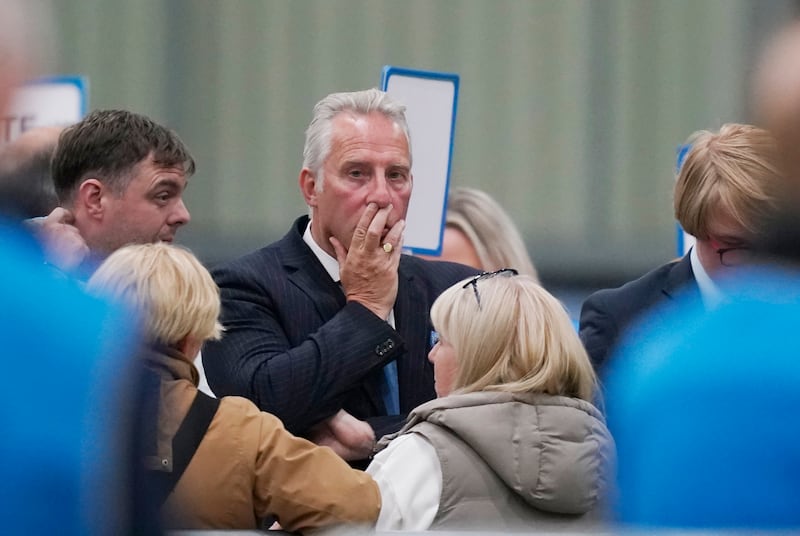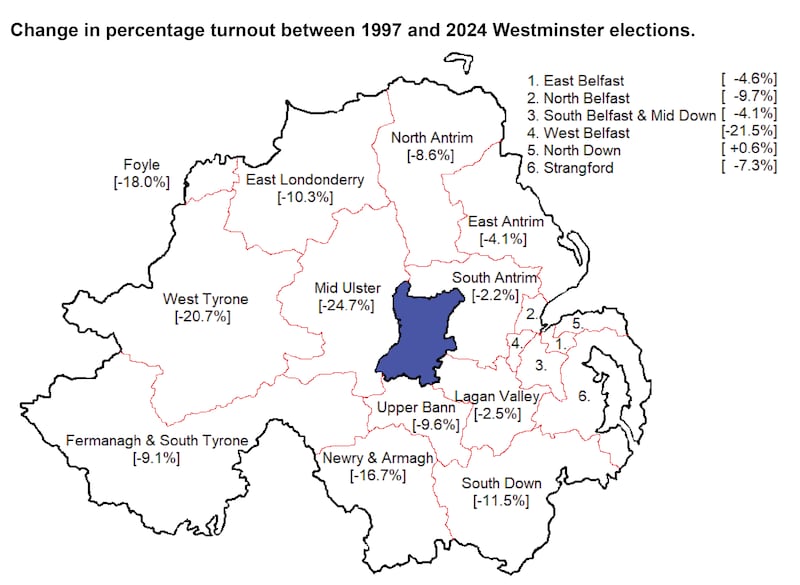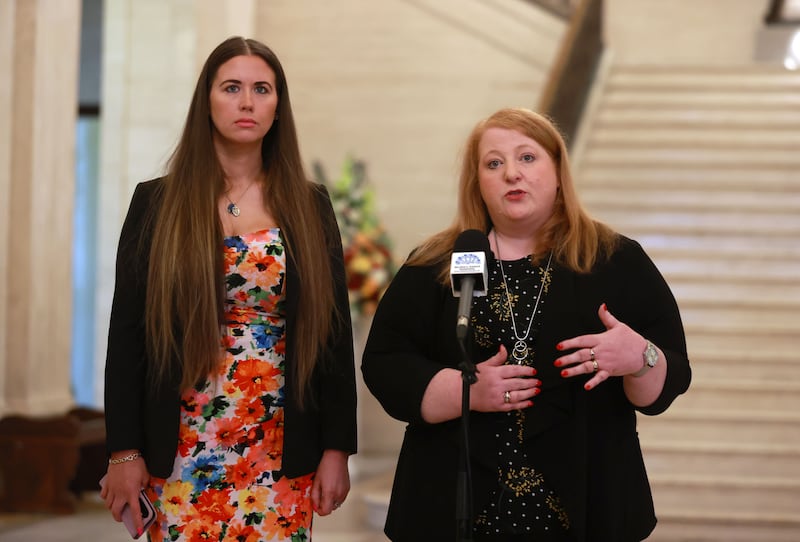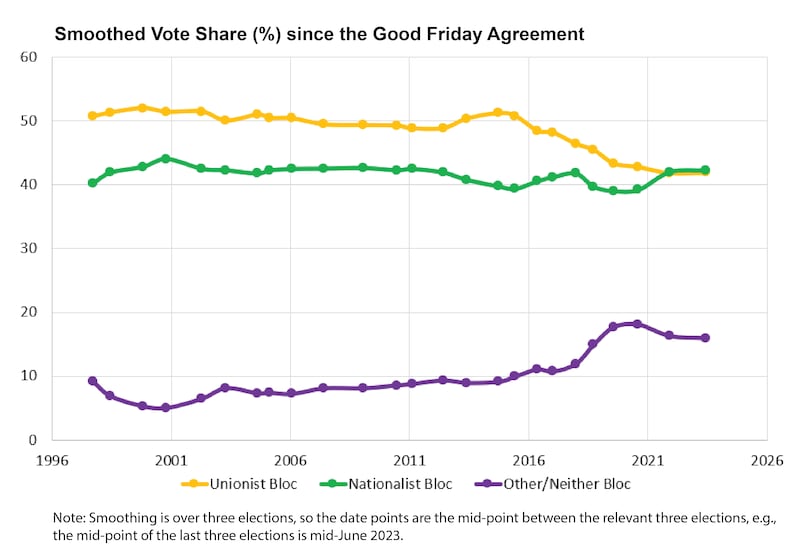In the UK general election of July 4th, Sinn Féin and the SDLP retained their seven and two seats respectively, ie half of Northern Ireland’s Westminster delegation. Sinn Féin came within 200 votes of ending Gregory Campbell’s tenure as the DUP MP for East Derry.
Had Kathleen McGurk succeeded in toppling Campbell, the nationalist bloc would have won an unprecedented simple majority of Northern Ireland’s MPs, though not of its votes. Sinn Féin will, however, be satisfied at becoming the largest party in the North for the third election in a row – after topping the polls in the most recent 2022 Assembly and 2023 local government elections.

The headline stories were in the unionist camp. The DUP lost three of its eight seats, defeated by Jim Allister of Traditional Unionist Voice (TUV) in North Antrim, by Robin Swann of the Ulster Unionist Party (UUP) in South Antrim, and by the Alliance Party’s Sorcha Eastwood in Lagan Valley. The fall of the “House of Paisley” was a stunning surprise to most, even though Ian Paisley jnr’s “serious misconduct” had long endangered his standing. The DUP is left not knowing which way to turn to recover.
[ The fall of Ian Paisley junior and the house of PaisleyOpens in new window ]
Should it follow Allister into a loveless marriage with Nigel Farage’s Reform UK? Or conduct detente with its old rival the UUP, which remains intent on recapturing Alliance supporters?
Experiences of Troubles victims have run like submerged streams beneath the dry land of blame
‘This new generation doesn’t like the past’: A night at a unionist meeting
Sinn Féin voters in the Republic and unionist voters in Northern Ireland agree on something
‘Simon Harris is not interested in this, period’: How Irish unity has slid down the political agenda
Less obvious was the emphatic halt to the Alliance’s recent growth, over-hyped by the party and in some commentary. Stephen Farry, with a reduced vote-share, lost North Down to an independent unionist, Alex Easton, who Farry described as having pulled off the masterstroke of not running under a DUP banner.
Naomi Long, Alliance’s leader, failed to dislodge Gavin Robinson of the DUP for the fourth consecutive Westminster election, losing by a greater margin than in 2019. Sorcha Eastwood’s success, while remarkable, owed something to the resignation of Jeffrey Donaldson, the DUP’s former leader, who is facing trial on historic rape and assault charges, as well as to the three-way split among unionist candidates who won nearly 60 per cent of the vote in Lagan Valley, and to the decision of Sinn Féin not to run a candidate to maximise her prospects.
Further intriguing developments, however, are apparent under these headlines. They were in turnout, party and bloc performances.
Voter turnout

Turnout at 57.2 per cent, was down in every constituency compared with the 2019 Westminster (61.8 per cent) and the 2022 Assembly (62.8 per cent) elections – mirroring the elections in Britain in this respect.
Despite a 5.4 per cent increase in the electorate since 2019, the number of valid votes dropped by 2.4 per cent. Four of the five largest drops in turnout happened in nationalist-majority constituencies. Turnout in West Belfast and Foyle now resembles that in safe east Ulster unionist seats. Sinn Féin’s abstentionist policy, and even its more circumspect campaigning on reunification, may be demotivating a significant proportion of its potential vote.
There have been major turnout changes in distinct constituencies since the mid-1990s. Figure 1 above shows that the largest decreases have occurred in nationalist strongholds, whereas the smallest decreases have occurred where Alliance is strongest. Since the Belfast Agreement, turnout west of the Bann has been converging downwards toward that of east Ulster. In 2024 the gap between the constituencies with highest and lowest turnouts was 13.4 per cent. The corresponding gap in 1997 was 28.7 per cent.
Party performances
Table 1 compares 2024 party performances in shares of the vote with those of 2019. Constituency boundaries had changed in the interim, so comparison is made with Nicholas Whyte’s “notional” figures for 2019, ie, retrospective estimates of the vote in 2019 had the 2024 boundaries applied..
Table 1:
Sinn Féin had the highest vote share in 2024 and increased its share by more than any other party compared to 2019. Its growth was almost mirrored by the drop in the SDLP’s share.There will be pressure on the SDLP seats in East Londonderry and Mid Ulster, from Sinn Féin. There may be an Alliance gain at the expense of the DUP in East Londonderry.
Nominally, the TUV’s increase in its vote share was the biggest, but that is slightly misleading because it started from what we must describe as a zero base in 2019.
The DUP was the big loser. One quarter of its votes may have leaked to the TUV, which damaged the DUP much as Reform crucified the Tories in Britain.
In Upper Bann, Carla Lockhart took 38 per cent of the UUP’s 2019 vote share to maintain her winning margin despite a Sinn Féin surge at the expense of the SDLP, a rare good-news story for the DUP in this election. She was also aided by the TUV’s decision not to stand.

Despite Sorcha Eastwood’s victory in Lagan Valley, Alliance’s vote share was down in 13 constituencies, with a particularly large drop in North Down, South Antrim, and South Down. Alliance sustained its position in East Antrim, taking a quarter of the vote (a drop of 0.4 per cent).
The incumbent Sammy Wilson, the DUP’s Brexit spokesperson, faced a significant challenge from John Stewart who increased the UUP’s vote by 7.3 per cent.
Despite winning South Antrim, however, the UUP’s vote share was essentially unchanged from 2019.
Bloc share
Looking at the votes in terms of block share, the others saw their share decline, compared to the 2019 result (see Table 2 below), while the nationalist and unionist blocs increased slightly.
Table 2:
Looking at the 11 seats where the five major parties stood and using the “notional” share for the revised boundaries for 2019, the other bloc vote share had a larger decline, and the nationalist bloc gained most of this drop.
Over the long run, however, the nationalist bloc share of the vote appears to have flatlined between the 1997 and 2024 Westminster elections (see Table 3 below).
Table 3:
But this picture ignores differential constituency turnouts across these elections, and the decision by Sinn Féin not to stand in four constituencies in 2024.
In the event of a referendum on reunification, the range of turnout differences between constituencies would probably be significantly smaller than in 1997.
If we apply the constituency bloc shares to the entire electorate for both elections, we find that the adjusted nationalist bloc has increased somewhat since 1997 (see Table 3), but that increase is much less than the growth of the other bloc.
The 2024 overall bloc shares also differ from the 2023 local election results. In 2023, rounding to whole numbers, the bloc shares were 44: 40: 16, for nationalists, unionists, and others respectively, the first time that the nationalists became the plurality bloc.
For 2024, when rounded, the bloc shares were 40: 43: 16, suggesting a unionist recovery. Turnout was broadly comparable (54 per cent for the local elections).
After appropriate recognition to the difference between local government and Westminster elections, how should we account for this 6.8 per cent swing from nationalist to unionist between 2023 and 2024, given the stability in the other bloc share?
Greater competition within the unionist bloc in single seats was important. The often bitter intra-unionist competition in eastern constituencies likely energised unionist voters, partially compensating for the electoral and demographic decline of their bloc. Turnout fell less in these seats, compared to the western constituencies and nationalist Belfast seats.
In 2023 the local election turnout gap between the lowest “electoral area” (Belfast – Titanic) and the highest (Fermanagh & Omagh – Erne East) was 28.5 per cent, comparable to the turnout gap in the 1997 Westminster election. But when we adjust for differential turnout, the nationalist to unionist swing between 2023 and 2024 reduces to 3.6 per cent.
Sinn Féin engaged in strategic withdrawals: it did not stand candidates in East Belfast, Lagan Valley and North Down to help Alliance, and that likely led to a drop in the nationalist bloc share, and resulted in a larger nationalist to unionist swing.
Moreover, no compelling issue raised its head during the 2024 campaign to trigger large turnouts in nationalist strongholds. Our view is that Sinn Féin’s abstentionist stance, its avoidance of focus on reunification, and its strategic withdrawals, may have demotivated some of its potential supporters from voting in its Belfast and Border strongholds.
Tactical voting by some SDLP voters may have boosted Alliance’s vote share in Lagan Valley.
So, although the final 2024 three-bloc N: U: O ratio was 40: 43: 16, if we add the notional share Sinn Féin might have gained in Lagan Valley had they stood a candidate (and subtract that share from Alliance), we would get a slight adjustment in the overall ratio to 41: 43: 16, ie, a slight reversal of the 2023 local election ratio of 44: 40: 16.
Differential constituency and electoral area turnout would appear to be the key explanations, but further analysis is required.
Predicting the 2027 Assembly election
Forecasting is a hazardous business, but all do it.
The 2024 UK general election party and bloc performances resembled the 2022 Assembly election results.
The addition of much of the Lecale peninsula to the Strangford constituency should lead to a first nationalist Assembly seat there, probably at the expense of Alliance. South Down also looks like another future Sinn Féin gain from Alliance.
There will be pressure on the SDLP seat in East Derry, from Sinn Féin, but that may lead to an Alliance gain at the expense of the DUP.
Doug Beattie’s UUP seat is under threat from Sinn Féin in Upper Bann.

The DUP may gain a seat from the UUP in East Belfast, but it may also lose one to the TUV in East Antrim. Despite losing North Antrim in 2024, the DUP may gain a seat from the UUP now that Robin Swann has vacated the Assembly. However, South Antrim looks like a gain from the DUP by the UUP.
Boundary changes in West Belfast look likely to lead to a DUP gain at the expense of Sinn Féin.
Overall, barring unexpected transformations, Sinn Féin is likely to be the biggest party (with 30 MLAs), with the nationalist bloc on 38 seats (SDLP, 7; People Before Profit, 1).
Unionists may have 36 seats (DUP, 26; UUP, 7; TUV, 2; and independent unionist Claire Sugden). Alex Easton has nominated a DUP councillor to replace him in the Assembly; we expect Peter Martin to retain his seat.
Alliance could return in 2027 with 16 seats, a net loss of one.
Disproportionality of Westminster elections
The winner-takes-all electoral system for Westminster in single member-seats is mistakenly described as “first past the post” – there is no fixed post! The system can lead to profoundly disproportional results: Labour’s 63 per cent of Westminster’s seats with 34 per cent of the vote is the exemplar.
Table 4 below shows the impact of winner-takes-all in Northern Ireland’s results. Since 1997, a majority of voters have never been represented through a party MP or independent of their choice. Differently put, more than three-quarters of seats since 1997 have been won with less than 50 per cent of the valid poll. Northern Ireland’s results, like those in Britain, advertise the case for electoral reform in Westminster elections.
Table four:
Currently, a communal electoral stalemate is apparent in the North (see Figure 2 below). The nationalist bloc is not leading in vote share in all elections; it hovers at between 40 and 44 per cent. It could consolidate its leadership if it increased turnout among its supporters. Sinn Féin is incrementally strengthening west of the Bann and in Belfast, while the SDLP’s slow decline continues.
The rise of the others has halted – at 16 per cent, Alliance at about13 per cent.
The unionist bloc has been falling but is still capable of shading nationalism as the plurality bloc, perhaps especially because of its competitive fragmentation – which otherwise weakens it.
Figure 2:

It may be this electoral stalemate will persist, but we can think of several political developments that may shake it up within this decade.
Sinn Féin could end its abstentionist platform and campaign to win a majority mandate in Westminster seats for a referendum in 2030 or after, though there is nothing in Sinn Féin’s public utterances to suggest the party is thinking of such a shift in policy.
Were Sinn Féin to say the IRA’s violent campaign after 1970 was not necessary, or that all sides were culpable in provoking violent conflict, it may capture some nationalist-transferring Alliance voters (who distrust Sinn Féin more than any other party according to a recent internet poll, and who prefer to transfer to the SDLP). Again, there is nothing in Sinn Féin’s utterances to indicate that it has any intention of doing such a thing. Would Sinn Féin be willing to lose some hardline supporters to seek more voters elsewhere?
A unionist pact between the DUP and the UUP is possible. Making it more likely are the strengthening of Gavin Robinson’s leadership; the weakening of the DUP old guard (Campbell, Paisley, and Wilson); and the end of DUP dominance by the UUP defectors, Arlene Foster and Donaldson. Such a reconfiguration, ie, joint candidates in Westminster elections, could make inroads into Alliance’s unionist-transferring voters, particularly if Stormont doesn’t collapse again. Are unionists capable of uniting on the Northern Ireland Protocol, and if the UUP and DUP offer a united front won’t they lose support to the TUV?
After 2025, a coalition government in Dublin, or a cross-party movement in the Republic, could set out a serious prospectus for a possible united Ireland, and thereby reshape a significant swathe of disengaged and “don’t know” opinion in the North. All parties in the Dáil support a united Ireland, but so far have not co-operated in developing such a prospectus.
Lastly, the overall performance of the UK polity could continue to worsen in comparison to that of the existing Republic, thereby also reshaping public opinion in the North. The Republic currently has persistent budgetary surpluses, a debt-to-GDP ratio less than half of the UK’s figure, and easier choices.
Keir Starmer’s new government promises to stop the bleeding of the UK state and economy. It has a hard task, and a limited mandate in votes.
Philip McGuinness is an independent scholar and a former lecturer in computer science at Dundalk Institute of Technology
Brendan O’Leary is Lauder Professor of Political Science and chair of the political science department at the University of Pennsylvania













